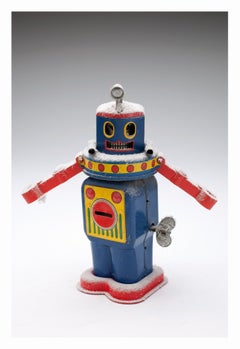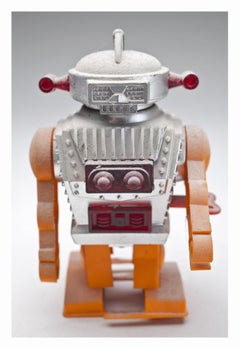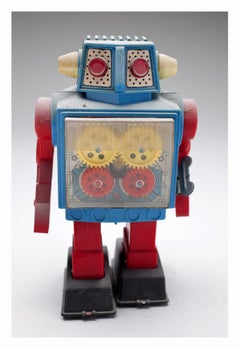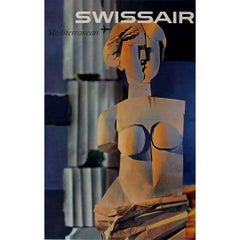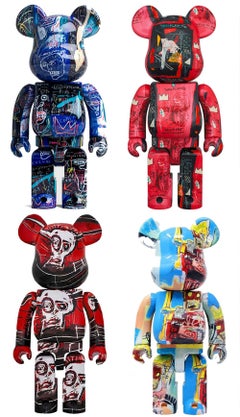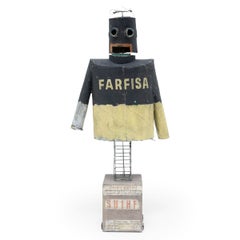Robot Art
to
7
62
5
5
5
10
Overall Width
to
Overall Height
to
7
80
1
1
2
2
1
29
19
12
10
3
1
1
52
6
1
87
150,639
78,559
49,952
42,228
36,027
34,511
29,675
26,180
26,152
24,207
20,244
17,149
15,859
14,790
13,604
13,111
10,863
10,289
10,163
38
28
24
17
16
38
6
6
4
3
2
7
74
9
Art Subject: Robot
Untitled (from ROBOTNICS Series)
Located in Kansas City, MO
Christian Rothmann
ROBOTNICS Series
C-Print
2019
Edition S (Edition of 10)
12 x 8.3 inches (30.5 x 21 cm)
Signed, dated and numbered verso
Other Edition Sizes available:
- Edition ...
Category
2010s Pop Art Photography
Materials
C Print
Untitled (from ROBOTNICS Series)
Located in Kansas City, MO
Christian Rothmann
ROBOTNICS Series
C-Print
2019
Edition S (Edition of 10)
12 x 8.3 inches (30.5 x 21 cm)
Signed, dated and numbered verso
Other Edition Sizes available:
- Edition ...
Category
2010s Contemporary Photography
Materials
C Print
Untitled (from ROBOTNICS Series)
Located in Kansas City, MO
Christian Rothmann
ROBOTNICS Series
C-Print
2019
Edition S (Edition of 10)
12 x 8.3 inches (30.5 x 21 cm)
Signed, dated and numbered verso
Other Edition Sizes available:
- Edition ...
Category
2010s Futurist Photography
Materials
C Print
1961 original poster for Swissair travels to the Mediterranean region - Greece
Located in PARIS, FR
The 1961 original poster titled "Swissair Mediterranean" by Nikolaus Schwabe is a captivating example of mid-20th century travel advertising. This poster was part of a series created...
Category
1960s Prints and Multiples
Materials
Linen, Lithograph, Paper
Basquiat Bearbrick 400% set of 4 works (Basquiat Be@rbrick)
Located in NEW YORK, NY
Jean-Michel Basquiat Bearbrick 400% Figures: Set of 4 works (c.2019-2021):
Unique, timeless Basquiat collectibles, each trademarked & licensed by the Estate of Jean-Michel Basquiat. ...
Category
21st Century and Contemporary Pop Art Prints and Multiples
Materials
Resin, Vinyl
"XMITTER" Helmet & Jacket Sculpture
Located in Chicago, IL
To Chicago-based artist Patrick Fitzgerald, his sculptures are a means of traveling through time. Working from found materials, Fitzgerald constructs miniature soap box cars...
Category
21st Century and Contemporary Outsider Art Figurative Sculptures
Materials
Wire
Basquiat Bearbrick 400% and 100% (Basquiat Be@rbrick)
Located in NEW YORK, NY
Jean-Michel Basquiat Bearbrick 400% Vinyl Figures: Set of two (400% & 100%):
A unique, timeless collectible trademarked & licensed by the Estate of Jean-Michel Basquiat. The partner...
Category
21st Century and Contemporary Street Art Prints and Multiples
Materials
Resin, Vinyl
What Your Children Will Look Like According to Gordon Moore
By Adam Mysock
Located in New Orleans, LA
After: Charles Hayter's Miniature Portrait of Sir Peter Francis Bourgeois (after Beechy) (1811) and an illustration by Ed Valigursky.
Framed: 10h x 8.50w in
In the late 1960s Intel cofounder Gordon...
Category
21st Century and Contemporary Contemporary Paintings
Materials
Acrylic, Panel
Andy Warhol Bearbrick 400% set of 4 (Warhol Be@rbrick)
By Andy Warhol
Located in NEW YORK, NY
Andy Warhol Bearbrick 400% Vinyl Figures: Set of four individual works (2020-2021):
(after) Andy Warhol Muhammad Ali, Elvis & Marilyn (pink & blue variations) collectibles trademarke...
Category
21st Century and Contemporary Pop Art Sculptures
Materials
Vinyl, Resin
Leonardo da Vinci Bearbrick 400% ( BE@RBRICK)
By Leonardo da Vinci
Located in NEW YORK, NY
Leonardo da Vinci 400% & 100% Bearbrick:
A unique, timeless Leonardo da Vinci collectible trademarked & licensed by the Louvre Museum Paris (Musee du Louvre). The partnered collectib...
Category
21st Century and Contemporary Pop Art Figurative Sculptures
Materials
Resin, Vinyl
Untitled (from ROBOTNICS Series)
Located in Kansas City, MO
Christian Rothmann
ROBOTNICS Series
C-Print
2019
Edition S (Edition of 10)
12 x 8.3 inches (30.5 x 21 cm)
Signed, dated and numbered verso
Other Edition Sizes available:
- Edition ...
Category
2010s Pop Art Photography
Materials
C Print
Untitled (from ROBOTNICS Series)
Located in Kansas City, MO
Christian Rothmann
ROBOTNICS Series
C-Print
2019
Edition S (Edition of 10)
12 x 8.3 inches (30.5 x 21 cm)
Signed, dated and numbered verso
Other Edition Sizes available:
- Edition M (Edition of 6) 35.4 x 23.6 inches (90 x 60 cm)
- Edition L (Edition of 6) 47.2 x 31.5 inches (120 x 80 cm)
- Edition XL (Edition of 3) 88.8 x 58.8 inches (225 x 150 cm)
PUR - Price Upon Request
--------------
Since 1979 Christian Rothmann had more than 40 solo and 80 group exhibitions worldwide.
Christian Rothmann had guest lectures, residencies, art fairs and biennials in Europe, Japan, USA, Australia and Korea.
Christian Rothmann (born 1954 in Kędzierzyn, Poland ) is a painter, photographer, and graphic artist.
In 1976 he first studied at the “Hochschule für Gestaltung” in Offenbach, Germany and moved to Berlin in 1977, where he graduated in 1983 at the “Hochschule der Künste”. From 1983 to 1995 he taught at the university as a lecturer and as an artist with a focus on screenprinting and American art history. To date, a versatile body of work has been created, which includes not only paintings but also long-standing photo projects, videos, and public art.
Guest lectures, teaching assignments, scholarships and exhibitions regularly lead Rothmann to travel home and abroad.
------------------------
Rothmann's Robots
These creatures date back to another era, and they connect the past and the future. They were found by Christian Rothmann, a Berlin artist, collector and traveler through time and the world: In shops in Germany and Japan, Israel and America, his keen eye picks out objects cast aside by previous generations, but which lend themselves to his own work. In a similar way, he came across a stash of historic toy robots of varied provenance collected by a Berlin gallery owner many years ago. Most of them were screwed and riveted together in the 1960s and 70s by Metal House, a Japanese company that still exists today. In systematically photographing these humanoids made of tin - and later plastic - Rothmann is paraphrasing the idea of appropriation art. Unknown names designed and made the toys, which some five decades on, Rothmann depicts and emblematizes in his extensive photo sequence.
In their photographs of Selim Varol's vast toy collection, his German colleagues Daniel and Geo Fuchs captured both the stereotypical and individual in plastic figures that imitate superheroes which were and still are generally manufactured somewhere in Asia. Christian Rothmann looks his robots deep in their artificially stylized, painted or corrugated eyes - or more aptly, their eye slits - and although each has a certain degree of individuality, the little figures remain unknown to us; they project nothing and are not alter egos. Rothmann trains his lens on their faces and expressions, and thus, his portraits are born. Up extremely close, dust, dents, and rust become visible. In other words, what we see is time-traces of time that has passed since the figures were made, or during their period in a Berlin attic, and - considering that he robots date back to Rothmann's childhood - time lived by the photographer and recipients of his pictures. But unlike dolls, these mechanical robots bear no reference to the ideal of beauty at the time of their manufacture, and their features are in no way modeled on a concrete child's face.
In this art project the robots appear as figures without a context, photographed face-on, cropped in front of a neutral background and reduced to their qualities of form. But beyond the reproduction and documentation a game with surfaces is going on; our view lingers on the outer skin of the object, or on the layer over it. The inside - which can be found beneath - is to an extent metaphysical, occurring inside the observer's mind. Only rarely is there anything to see behind the robot's helmet. When an occasional human face does peer out, it turns the figure into a robot-like protective casing for an astronaut of the future.
If we really stop and think about modern toys, let's say those produced from the mid 20th century, when Disney and Marvel films were already stimulating a massive appetite for merchandising, the question must be: do such fantasy and hybrid creatures belong, does something like artificial intelligence already belong to the broader community of humans and animals? It is already a decade or two since the wave of Tamagotchis washed in from Japan, moved children to feed and entertain their newly born electronic chicks in the way they would a real pet, or to run the risk of seeing them die. It was a new form of artificial life, but the relationship between people and machines becomes problematic when the machines or humanoid robots have excellent fine motor skills and artificial intelligence and sensitivity on a par with, or even greater than that of humans. Luckily we have not reached that point yet, even if Hollywood adaptations would have us believe we are not far away.
Rothmann's robots are initially sweet toys, and each toy is known to have a different effect on children and adults. They are conceived by (adult) designers as a means of translating or retelling history or reality through miniature animals, knights, and soldiers. In the case of monsters, mythical creatures, and robots, it is more about creating visions of the future and parallel worlds. Certainly, since the success of fantasy books and films such as Lord of the Rings or The Hobbit, we see the potential for vast enthusiasm for such parallel worlds. Successful computer and online games such as World
of Warcraft, or the creation of avatars are also interesting worldwide phenomena of virtual realities that are not only relevant for children and teens.
So when a middle-aged Berlin photographic artist (like Christian Rothmann) chooses to study 120 toy robots with great difference in form, it represents a journey back to his own childhood - even if at the time, he played with a steam engine rather than a robot. Once batteries had been inserted, some of the largely male or gender-neutral robots, could flash, shoot, turn around and even do more complicated things. Some can even still do it today - albeit clumsily. This, of course, can only be seen on film, but the artist intends to document that as well; to feature the robots in filmic works of art.
The positioning of the figures in the studio is the same as the tableau of pictures in the exhibition room. In this way, one could say Rothmann deploys one robot after the other. This systematic approach enables a comparative view; the extreme enlargement of what are actually small and manageable figures is like the macro vision of insects whose fascinating, sometimes monster-like appearance only becomes visible when they are blown up a hundredfold. The same thing goes for the robots; in miniature form, they seem harmless and cute, but if they were larger than humans and made noises to match, they would seem more threatening.
Some of the tin figures...
Category
2010s Contemporary Photography
Materials
C Print
Untitled (from ROBOTNICS Series)
Located in Kansas City, MO
Christian Rothmann
ROBOTNICS Series
C-Print
2019
Edition S (Edition of 10)
12 x 8.3 inches (30.5 x 21 cm)
Signed, dated and numbered verso
Other Edition Sizes available:
- Edition ...
Category
2010s Pop Art Photography
Materials
C Print
Untitled (from ROBOTNICS Series)
Located in Kansas City, MO
Christian Rothmann
ROBOTNICS Series
C-Print
2019
Edition S (Edition of 10)
12 x 8.3 inches (30.5 x 21 cm)
Signed, dated and numbered verso
Other Edition Sizes available:
- Edition ...
Category
2010s Modern Photography
Materials
C Print
Untitled (from ROBOTNICS Series)
Located in Kansas City, MO
Christian Rothmann
ROBOTNICS Series
C-Print
2019
Edition S (Edition of 10)
12 x 8.3 inches (30.5 x 21 cm)
Signed, dated and numbered verso
Other Edition Sizes available:
- Edition ...
Category
2010s Outsider Art Photography
Materials
C Print
Untitled (from ROBOTNICS Series)
Located in Kansas City, MO
Christian Rothmann
ROBOTNICS Series
C-Print
2019
Edition S (Edition of 10)
12 x 8.3 inches (30.5 x 21 cm)
Signed, dated and numbered verso
Other Edition Sizes available:
- Edition M (Edition of 6) 35.4 x 23.6 inches (90 x 60 cm)
- Edition L (Edition of 6) 47.2 x 31.5 inches (120 x 80 cm)
- Edition XL (Edition of 3) 88.8 x 58.8 inches (225 x 150 cm)
PUR - Price Upon Request
--------------
Since 1979 Christian Rothmann had more than 40 solo and 80 group exhibitions worldwide.
Christian Rothmann had guest lectures, residencies, art fairs and biennials in Europe, Japan, USA, Australia and Korea.
Christian Rothmann (born 1954 in Kędzierzyn, Poland ) is a painter, photographer, and graphic artist.
In 1976 he first studied at the “Hochschule für Gestaltung” in Offenbach, Germany and moved to Berlin in 1977, where he graduated in 1983 at the “Hochschule der Künste”. From 1983 to 1995 he taught at the university as a lecturer and as an artist with a focus on screenprinting and American art history. To date, a versatile body of work has been created, which includes not only paintings but also long-standing photo projects, videos, and public art.
Guest lectures, teaching assignments, scholarships and exhibitions regularly lead Rothmann to travel home and abroad.
------------------------------------------------------
Rothmann's Robots
These creatures date back to another era, and they connect the past and the future. They were found by Christian Rothmann, a Berlin artist, collector and traveller through time and the world: In shops in Germany and Japan, Israel and America, his keen eye picks out objects cast aside by previous generations , but which lend themselves to his own work. In a similar way he came across a stash of historic toy robots of varied provenance collected by a Berlin gallery owner many years ago. Most of them were screwed and riveted together in the 1960s and 70s by Metal House, a Japanese company that still exists today. In systematically photographing these humanoids made of tin - and later plastic - Rothmann is paraphrasing the idea of appropriation art. Unknown names designed and made the toys, which some five decades on, Rothmann depicts and emblematizes in his extensive photo sequence.
In their photographs of Selim Varol's vast toy collection, his German colleagues Daniel and Geo Fuchs captured both the stereotypcal and individual in plastic figures that imitate superheroes which were and still are generally manufactured somewhere in Asia. Christian Rothmann looks his robots deep in their artificially stylised, painted or corrugated eyes - or more aptly, their eye slits - and although each has a certain degree of individuality, the little figures remain unknown to us; they project nothing, and are not alter egos. Rothmann trains his lens on their faces and expressions, and thus, his portraits are born. Up extremely close, dust, dents and rust become visible. In other words, what we see is time-traces of time that has passed since the figures were made, or during their period in a Berlin attic, and - considering that he robots date back to Rothmann's childhood - time lived by the photographer and recipients of his pictures. But unlike dolls, these mechanical robots bear no reference to the ideal of beauty at the time of their
manufacture, and their features are in no way modelled on a concrete child's face.
In this art project the robots appear as figures without a context, photographed face-on, cropped in front of a neutral background and reduced to their qualities of form. But beyond the reproduction and documentation a game with surfaces is going on; our view lingers on the outer skin of the object, or on
the layer over it. The inside - which can be found beneath - is to an extent metaphysical, occurring inside the observer's mind. Only rarely is there anything to see behind the robot's helmet. When an occasional human face does peer out, it turns the figure into a robot-like protective casing for an astronaut of the future.
If we really stop and think about modern toys, let's say those produced from the mid 20th century, when Disney and Marvel films were already stimulating a massive appetite for merchandising, the question must be: do such fantasy and hybrid creatures belong, does something like artificial intelligence already belong to the broader community of humans and animals? It is already a decade or two since the wave of Tamagotchis washed in from Japan, moved children to feed and entertain their newly born electronic chicks in the way they would a real pet, or to run the risk of seeing them die. It was a new form of artificial life, but the relationship between people and machines becomes problematic when the machines or humanoid robots have excellent fine motor skills and artificial intelligence and sensitivity on a par with, or even greater than that of humans. Luckily we have not reached that point yet, even if Hollywood adaptations would have us believe we are not far away.
Rothmann's robots are initially sweet toys; and each toy is known to have a different effect on children and adults. They are conceived by (adult) designers as a means of translating or retelling history or reality through miniature animals, knights and soldiers. In the case of monsters, mythical creatures and robots, it is more about creating visions of the future and parallel worlds. Certainly since the success of fantasy books and films such as Lord of the Rings or The Hobbit, we see the potential for vast enthusiasm for such parallel worlds. Successful computer and online games such as World
of Warcraft, or the creation of avatars are also interesting worldwide phenomena of virtual realities that are not only relevant for children and teens.
So when a middle-aged Berlin photographic artist (like Christian Rothmann) chooses to study 120 toy robots with great difference in form, it represents a journey back to his own childhood - even if at the time, he played with a steam engine rather than a robot. Once batteries had been inserted, some of
the largely male or gender neutral robots, could flash, shoot, turn around and even do more complicated things. Some can even still do it today - albeit clumsily. This of course can only be seen on film, but the artist intends to document that as well; to feature the robots in filmic works of art.
The positioning of the figures in the studio is the same as the tableau of pictures in the exhibition room. In this way, one could say Rothmann deploys one robot after the other. This systematic approach enables a comparative view; the extreme enlargement of what are actually small and manageable figures is like the macro vision of insects whose fascinating, sometimes monster-like appearance only becomes visible when they are blown up a hundredfold. The same thing goes for the robots; in miniature form they seem harmless and cute, but if they were larger than humans and made noises to match, they
would seem more threatening.
Some of the tin figures...
Category
2010s Contemporary Photography
Materials
C Print
Urashimo Taro's Journey of Love
Located in PARIS, FR
2022, 8 Editions
Stainless steel polished and plated
31 1/2 × 19 7/10 × 19 7/10 in - 80 × 50 × 50 cm
The artwork is signed by the Artist , carved with edition number and date under t...
Category
2010s Contemporary Sculptures
Materials
Stainless Steel
Smile on!, Photograph, Archival Ink Jet
Located in Yardley, PA
This photograph is from my Remote series. Remote series crafts a salient commentary on the reality of modern daily life. I captured moments stolen from popular culture and condensed ...
Category
Early 2000s Other Art Style Color Photography
Materials
Archival Ink
Korean Contemporary Art by Hyun Deok-Sik - One More
Located in Paris, IDF
Ink on Jang-Ji paper, dye, pigment & Ottchil on panel
Hyun Deok-Sik is a Korean artist born in 1979 who lives and works in Jeju Island, South Korea. He is graduated from the departm...
Category
2010s Figurative Paintings
Materials
Dye, Paper, Ink, Panel, Pigment
$756 Sale Price
20% Off
Le penseur
Located in Montreal, Quebec
Guillaume Lachapelle’s artistic practice is shaped predominantly by sculpture, expressed in the form of installations and detailed miniature models. Lachapelle presents playful unive...
Category
2010s Contemporary Figurative Sculptures
Materials
Nylon
Asimo's Dance in the Nocturnal Symphony : Mechanical ballet
By Hiro Ando
Located in PARIS, FR
2009, unique artwork
oil on canvas
42 1/2 × 63 3/4 in - 108 × 162 cm
The artwork is signed by the Artist & stamped with the logo of the Artist's Studio on verso of the canvas
The art...
Category
2010s Contemporary Paintings
Materials
Oil
Centaure (large)
Located in Montreal, Quebec
Guillaume Lachapelle’s artistic practice is shaped predominantly by sculpture, expressed in the form of installations and detailed miniature models. Lachapelle presents playful unive...
Category
2010s Contemporary Figurative Sculptures
Materials
Nylon
Centaure
Located in Montreal, Quebec
Guillaume Lachapelle’s artistic practice is shaped predominantly by sculpture, expressed in the form of installations and detailed miniature models. Lachapelle presents playful unive...
Category
2010s Contemporary Figurative Sculptures
Materials
Nylon
Reckless
By Jim Molloy
Located in New York, NY
Oil painting of car on a curve. Sunglasses hang from the steering wheel. Tone is engaging, fun with universal appeal.
About the artist:
Molloy...
Category
2010s Contemporary Figurative Paintings
Materials
Canvas, Oil
$7,500
Phytosanitary: Jack the Gardener
Located in New Orleans, LA
Thierry Job was born in Marseille, France and currently lives in San Miguel de Allende, Mexico. He studied art at the School of Beaux Arts in Paris. His wo...
Category
2010s Contemporary Figurative Sculptures
Materials
Steel
Price Upon Request
Breath
Located in New Orleans, LA
Thierry Job was born in Marseille, France and currently lives in San Miguel de Allende, Mexico. He studied art at the School of Beaux Arts in Paris. His works as been exhibited at th...
Category
2010s Contemporary Figurative Sculptures
Materials
Steel
Price Upon Request
Time Bond
By Mark Kostabi
Located in Long Island City, NY
Artist: Mark Kostabi, American (1960 - )
Title: Time Bond
Year: 1988
Medium: Acrylic on Canvas, signed verso
Size: 84 x 48 in. (213.36 x 121.92 cm)
Category
1980s Surrealist Figurative Paintings
Materials
Canvas, Acrylic
Price Upon Request
Recently Viewed
View AllMore Ways To Browse
John L Eastman
Joseph Dixon
Juan Francisco Casas
Karl Hartman
Koi Mirror
Kusama Pumpkin Print
Lajos Markos
Landscape Paintings Craze
Leon Lhermitte
Lion Salvador Dali
Mahonri Young
Mick Jagger Poster Vintage
Mid Century Walking Man Sculpture
Mike Hammer
Mini Pop H
Original Painting Horse Fox Hunt
Ospaaal Poster
Pepsi Bottles
